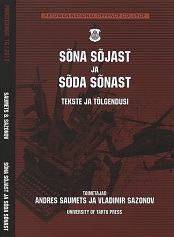Sõda ja allilm regilauludes ning arhailises teadvuses
War and Otherworld in Estonian Kalevala-metric Songs and Archaic Thinking
Author(s): Madis ArukaskSubject(s): Customs / Folklore
Published by: Kaitseväe Ühendatud Õppeasutused
Summary/Abstract: Estonian Kalevala-metric song, regilaul in Estonian, is a genre of folklore which originates from the Bronze Age around 2000–3000 years ago. Several changes in the function and language of songs have taken place over time: from mythological coding (which was most probably the main function of the songs) to social protest by Estonian serfs in the 18th–19th century. Mythological themes later transformed into epic narration; at the same time intertextual transitions took place between songs, laments, charms and other folklore genres related to folk belief and rituals. In the last few centuries modern individual-oriented lyricism has reconceptualised and restructured many aspects of Estonian popular culture (including Setu), reshaping and recreating lots of folkloric storylines as well. The records of regilaul that can be used for research today were mainly compiled during the late period, in the 19th century and later. All this makes diachronic study of the genre quite complicated. As war-related topics can be found in such songs, this throws up questions about their origin and the context in which they were performed during different historical periods. In oral culture it is not easy to follow any particular historical linearity. Instead, it should be considered that there have existed various agents and backgrounds in parallel, based on social class, gender and/or cultural origin in general. In this way, just one song’s storyline could go through many changes, all of which should be taken into account for research purposes. In addition, the common poetic vocabulary and motifs suggest an interweaving of different genres (i.e., regilaul and lament). A common feature of (thematically) war-related songs is that they are not very epic in nature. Instead, some other voice and/or discourse is predominant in them. The most common explanation for that is simple emphasis of the feminine, pacifistic feelings typical of Estonian culture. At the same time, more archaic ritual thinking can be found here, where, instead of modern self-centeredness, an older sense of functionality more typical of laments can be found, the purpose of which was to initiate the departing one (to war, otherworld, new status) and to instruct and safeguard him magically. In the poetic language of many songs a certain similarity or even coincidence between poetical figures about the war and otherworld can be observed. This is also true of the most popular Estonian war-related regilaul „Venna sõjalugu” (“The Brother’s War-Story”). It is possible to approach this song as a purely epic, masculine piece of work when using international parallels. Using the story-pattern of Return Song elaborated in Oral-Formulaic Theory as universal example, it can be easily shown that the heroic epic once existed in the Estonian regilaul tradition... (contin.)
Journal: KVÜÕA toimetised
- Issue Year: 2012
- Issue No: 16
- Page Range: 204-224
- Page Count: 21
- Language: Estonian

